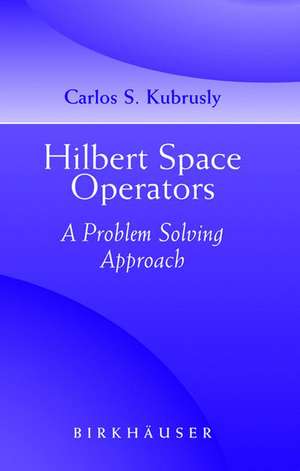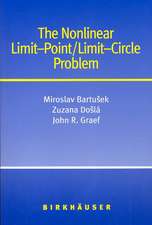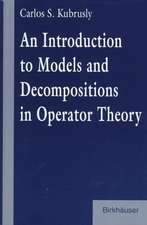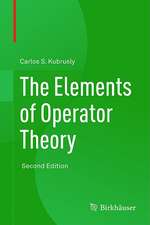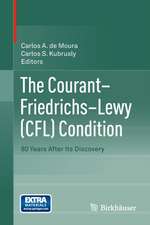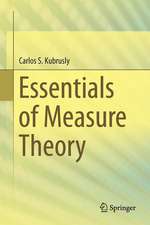Hilbert Space Operators: A Problem Solving Approach
Autor Carlos S. Kubruslyen Limba Engleză Paperback – 7 aug 2003
Preț: 382.75 lei
Nou
Puncte Express: 574
Preț estimativ în valută:
73.24€ • 78.32$ • 61.07£
73.24€ • 78.32$ • 61.07£
Carte tipărită la comandă
Livrare economică 18 aprilie-02 mai
Preluare comenzi: 021 569.72.76
Specificații
ISBN-13: 9780817632427
ISBN-10: 0817632425
Pagini: 149
Ilustrații: XIII, 149 p.
Dimensiuni: 155 x 235 x 11 mm
Greutate: 0.29 kg
Ediția:2003
Editura: Birkhäuser Boston
Colecția Birkhäuser
Locul publicării:Boston, MA, United States
ISBN-10: 0817632425
Pagini: 149
Ilustrații: XIII, 149 p.
Dimensiuni: 155 x 235 x 11 mm
Greutate: 0.29 kg
Ediția:2003
Editura: Birkhäuser Boston
Colecția Birkhäuser
Locul publicării:Boston, MA, United States
Public țintă
ResearchCuprins
1 Invariant Subspaces.- Problem 1.1 Closure.- Problem 1.2 Kernel and Range.- Problem 1.3 Null Product.- Problem 1.4 Operator Equation.- Problem 1.5 Nilpotent and Algebraic.- Problem 1.6 Polynomials.- Problem 1.7 Totally Cyclic.- Problem 1.8 Densely Intertwined.- Problem 1.9 Hyperinvariant.- Problem 1.10 Quasiaffine Transform.- Solutions.- 2 Hilbert Space Operators.- Problem 2.1 Adjoint.- Problem 2.2 Nonnegative.- Problem 2.3 Contraction.- Problem 2.4 Normal.- Problem 2.5 Isometry.- Problem 2.6 Unitary.- Problem 2.7 Projection.- Problem 2.8 Mutually Orthogonal.- Problem 2.9 Increasing.- Solutions.- 3 Convergence and Stability.- Problem 3.1 Diagonal.- Problem 3.2 Product.- Problem 3.3 * -Preserving.- Problem 3.4 Nonnegative.- Problem 3.5 Monotone.- Problem 3.6 Self-Adjoint.- Problem 3.7 Commutant.- Problem 3.8 Convex Cone.- Problem 3.9 Absolute Value.- Solutions.- 4 Reducing Subspaces.- Problem 4.1 T-Invariant.- Problem 4.2 Matrix Form.- Problem 4.3 T*-Invariant.- Problem 4.4 T and T*-Invariant.- Problem 4.5 Commuting with T and T*.- Problem 4.6 Reducible.- Problem 4.7 Restriction.- Problem 4.8 Direct Sum.- Problem 4.9 Unitarily Equivalent.- Problem 4.10 Unitary Restriction.- Solutions.- 5 Shifts.- Problem 5.1 Unilateral.- Problem 5.2 Bilateral.- Problem 5.3 Multiplicity.- Problem 5.4 Unitarily Equivalent.- Problem 5.5 Reducible.- Problem 5.6 Irreducible.- Problem 5.7 Rotation.- Problem 5.8 Riemann-Lebesgue Lemma.- Problem 5.9 Weighted Shift.- Problem 5.10 Nonnegative Weights.- Solutions.- 6 Decompositions.- Problem 6.1 Strong Limit.- Problem 6.2 Projection.- Problem 6.3 Kernels.- Problem 6.4 Kernel Decomposition.- Problem 6.5 Intertwined to Isometry.- Problem 6.6 Dual Limits.- Problem 6.7 Nagy-Foia?-Langer Decomposition.- Problem 6.8 von Neumann-Wold Decomposition.-Problem 6.9 Another Decomposition.- Problem 6.10 Foguel Decomposition.- Problem 6.11 Isometry.- Problem 6.12 Coisometry.- Problem 6.13 Strongly Stable.- Problem 6.14 Property PF.- Problem 6.15 Direct Summand.- Solutions.- 7 Hyponormal Operators.- Problem 7.1 Quasinormal.- Problem 7.2 Strong Stability.- Problem 7.3 Hyponormal.- Problem 7.4 Direct Proof.- Problem 7.5 Invariant Subspace.- Problem 7.6 Restriction.- Problem 7.7 Normal.- Problem 7.8 Roots of Powers.- Problem 7.9 Normaloid.- Problem 7.10 Power Inequality.- Problem 7.11 Unitarily Equivalent.- Problem 7.12 Subnormal.- Problem 7.13 Not Subnormal.- Problem 7.14 Distinct Weights.- Solutions.- 8 Spectral Properties.- Problem 8.1 Spectrum.- Problem 8.2 Eigenspace.- Problem 8.3 Examples.- Problem 8.4 Residual Spectrum.- Problem 8.5 Weighted Shift.- Problem 8.6 Uniform Stability.- Problem 8.7 Finite Rank.- Problem 8.8 Stability for Compact.- Problem 8.9 Continuous Spectrum.- Problem 8.10 Compact Contraction.- Problem 8.11 Normal.- Problem 8.12 Square Root.- Problem 8.13 Fuglede Theorem.- Problem 8.14 Quasinormal.- Problem 8.15 Fuglede-Putnam Theorem.- Problem 8.16 Reducible.- Solutions.- 9 Paranormal Operators.- Problem 9.1 Quasihyponormal.- Problem 9.2 Semi-quasihyponormal.- Problem 9.3 Paranormal.- Problem 9.4 Square of Paranormal.- Problem 9.5 Alternative Definition.- Problem 9.6 Unitarily Equivalent.- Problem 9.7 Weighted Shift.- Problem 9.8 Equivalences.- Problem 9.9 Not Paranormal.- Problem 9.10 Projection ? Nilpotent.- Problem 9.11 Shifted Operators.- Problem 9.12 Shifted Projections.- Problem 9.13 Shifted Seif-Adjoints.- Problem 9.14 Examples.- Problem 9.15 Hyponormal.- Problem 9.16 Invertible.- Problem 9.17 Paranormal Inequality.- Problem 9.18 Normaloid.- Problem 9.19 Cohyponormal.- Problem 9.20 StronglyStable.- Problem 9.21 Quasinormal.- Solutions.- 10 Proper Contractions.- Problem 10.1 Equivalences.- Problem 10.2 Diagonal.- Problem 10.3 Compact.- Problem 10.4 Adjoint.- Problem 10.5 Paranormal.- Problem 10.6 Nagy-Foia? Classes.- Problem 10.7 Weakly Stable.- Problem 10.8 Hyponormal.- Problem 10.9 Subnormal.- Problem 10.10 Quasinormal.- Problem 10.11 Direct Proof.- Problem 10.12 Invariant Subspace.- Solutions.- 11 Quasireducible Operators.- Problem 11.1 Alternative Definition.- Problem 11.2 Basic Properties.- Problem 11.3 Nilpotent.- Problem 11.4 Index 2.- Problem 11.5 Higher Indices.- Problem 11.6 Product.- Problem 11.7 Unitarily Equivalent.- Problem 11.8 Similarity.- Problem 11.9 Unilateral Shift.- Problem 11.10 Isometry.- Problem 11.11 Quasinormal.- Problem 11.12 Weighted Shift.- Problem 11.13 Subnormal.- Problem 11.14 Commutator.- Problem 11.15 Reducible.- Problem 11.16 Normal.- Solutions.- 12 The Lomonosov Theorem.- Problem 12.1 Hilden’s Proof.- Problem 12.2 Lomonosov Lemma.- Problem 12.3 Lomonosov Theorem.- Problem 12.4 Extension.- Problem 12.5 Quasireducible.- Problem 12.6 Hyponormal.- Solutions.- References.
Recenzii
"…the author treats many new subjects of operator theory for graduate students and mathematicians, i.e., quasihyponormal operators, paranormal operators, proper contractions, quasireducible operators, a detailed presentation of the Lomonosov theorem on nontrivial hyperinvariant subspaces for compact operators, etc. This book will be of benefit to graduate students (in mathematics, physics, engineering, economics, and statistics) and many mathematicians."
—Zentralblatt MATH
"…many totally new subjects are offered to the potential reader…. The author has great teaching experience reflected by the skillful selection of background material, the gradual statements of the problems, and the detailed presentation of the solutions. The book is intended [for] an audience mainly formed by various types of graduate students: in mathematics, statistics, physics and, perhaps, in engineering and economics. It can be useful even for working mathematicians, as a reference book in a broad sense…."
—Mathematical Reviews
—Zentralblatt MATH
"…many totally new subjects are offered to the potential reader…. The author has great teaching experience reflected by the skillful selection of background material, the gradual statements of the problems, and the detailed presentation of the solutions. The book is intended [for] an audience mainly formed by various types of graduate students: in mathematics, statistics, physics and, perhaps, in engineering and economics. It can be useful even for working mathematicians, as a reference book in a broad sense…."
—Mathematical Reviews
